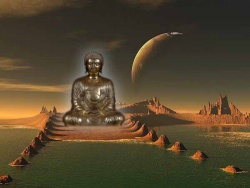3 vehicles
The 3 vehicles - Theravada, Mahayana (Great Vehicle) & Vajrayana (Diamond Vehicle) are similar in essence, and differ in terms of how the Dharma is being packaged - e.g. difference in monks' robes, areas of emphasis & practice methods.
Like a cup of tea (Dharma) may be placed in a golden cup, a teacup, a glass, or a triangular-shaped cup, the external shape (practice methods) may seem different, but the inner essence (tea, i.e. Dharma) remains the same.
Theravada, sometimes we refer to it as Buddhism transmitted from the Southern Route (nan2 chuan2 fo2 jiao4). It spread from India to most parts of Southeast Asia, like Thailand, Myanmar, Laos, Sri Lanka, Vietnam, Singapore, Malaysia. The emphasis of practice is generally on observing strict precepts and the goal is to attain Arahantship, by extinguishing the conditions (eg. greed, hatred, ignorance) for continued Samsaric existence. There is usually a strong tradition of Shamatha (concentration) and Vipassanna (analytical/insight) meditation.
Mahayana is sometimes referred to as Buddhism transmitted from the Northern Route (bei3 chuan2 fo2 jiao4). It spread to places like China, Japan, Korea, Vietnam, Singapore, Malaysia. The emphasis of practice is generally on the 6 Perfections (Perfection of generosity, morality, patience, joyous effort, concentration, wisdom). The goal is to attain Buddhahood, for the sake of benefiting all sentient beings (also referred to as Bodhicitta). Besides Buddhas, Mahayanists also believe in Bodhisattvas, who appear in the world so as to benefit sentient beings. It is said that one needs to practice the 6 Perfections as a Bodhisattva for 3 countless aeons, in order to become enlightened. Examples of Mahayana traditions include Pureland, Zen, Chinese Ch'an, Hua Yen, etc.
Vajrayana is actually a branch of Mahayana. It also has a very strong emphasis on Bodhicitta. In fact, the sense of urgency in wanting to benefit all sentient beings is so great that a Vajrayana practitioner wants to quickly attain enlightenment. As such, they use extremely efficient methods that could allow one to attain enlightenment very quickly (in some cases, within one lifetime). However, it is said that when it's faster, the practice is more dangerous - dangerous because one's motivation is hardly pure. It is said that when one practices Vajrayana, it is like a snake climbing inside a bamboo pole. It needs to continually climbing upwards, if not it could easily slide down. If one wants to learn Vajrayana, one needs to find an excellent teacher, who is qualified to teach you. And in the scriptures, it is advised that the student takes 3 years to examine the teacher. The teacher must have compassion, and hopefully has at least a glimpse of emptiness.
Mahayana is sometimes also referred to as the Causal Path, while Vajrayana the Result Path. This is because Mahayana practice basically gets one to plant the seeds of Bodhisattvahood and Buddhahood. Whereas Vajrayana practices operate from the premise that your original state is already enlightened (Buddha Nature, or basic goodness), therefore all you need to do is to remove the temporal contaminations (greed, anger, ignorance, pride, jealousy etc) and get used to your Buddha Nature. (Pardon me if it's not very clear, I'm just trying to grossly summarize the Vajrayana practice here.) Today, Vajrayana is practiced in Tibet, Nepal, India, China, Japan, Singapore, Malaysia, I heard in Myanmar there is too, but I'm not too sure.
It actually doesn't really matter which vehicle one chooses, as all will eventually lead to liberation. It also depends on our own karmic connections with the various traditions.
